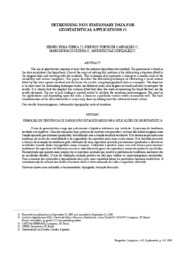Detrending non stationary data for geostatistical applications.
Detrending non stationary data for geostatistical applications.
Author(s): VIEIRA, S. R.; CARVALHO, J. R. P. de; CEDDIA, M. C.; PAZ GONZÁLEZ
Summary: The use of geostatistics requires at least that the intrinsic hypothesis be satisfied. The presence of a trend in the data invalidates this hypothesis. One of the ways of solving this problem is by subtracting a function fitted to the original data and working with the residuals. This technique also represents a change to a smaller scale of the variability and surface roughness. This paper describes the detrending technique of subtracting a trend surface fitted by the least squares method and discusses the results using topographical data as examples. The objective is to show how the detrending technique works for different scales and degrees of trend and how to interpret the results. It is shown that the simplest the surfaces fitted that does the work of removing the trend the best are the results obtained. The use of jack knifing is proved useful to validate the resulting semivariograms. For most of the applications and depending upon the scale, a linear or a parabolic surface works reasonably well. The back transformation of the data afterwards is very easily done by adding back the subtracted trend surface.
Publication year: 2010
Types of publication: Journal article
Observation
Some of Embrapa's publications are published as ePub files. To read them, use or download one of the following free software options to your computer or mobile device. Android: Google Play Books; IOS: iBooks; Windows and Linux: Calibre.
Access other publications
Access the Agricultural Research Database (BDPA) to consult Embrapa's full library collection and records.
Visit Embrapa Bookstore to purchase books and other publications sold by Embrapa.

